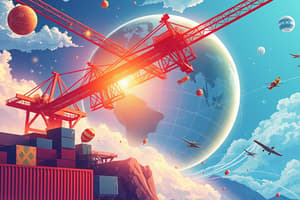Podcast
Questions and Answers
Question 1
Question 1
What were the main causes of World War II?
Answer 1
Answer 1
The Treaty of Versailles, the rise of Adolf Hitler and the Nazi Party, and Germany's expansion through the Axis powers.
Question 2
Question 2
What was the significance of the United States' involvement in World War II?
Answer 2
Answer 2
Question 3
Question 3
Answer 3
Answer 3
Question 1
Question 1
Answer 1
Answer 1
Question 2
Question 2
Answer 2
Answer 2
Question 3
Question 3
Answer 3
Answer 3
Flashcards are hidden until you start studying
Study Notes
A Brief History of World War II
- World War II can be traced back to decisions made at the end of World War I, where Germany was blamed for causing hostility and received the brunt of the guilt.
- Germany was hit hard by the global financial crash of 1929, which worsened the nation's deep depression, and the rise of Adolf Hitler gave the people hope.
- The Treaty of Versailles left many countries with internal wars and the rise of communism in Russia threatened the fascist movements in Europe.
- Hitler became the leader of the Nazi Party in Germany, promoting anti-semitism, Aryan superiority, and ethnic cleansing of minorities.
- Germany formed the Axis powers, allying with Japan and Italy, and began expanding its territory by invading Poland, Denmark, Norway, Austria, and Czechoslovakia.
- France and Britain saw Germany as a serious threat, and the war officially began when Germany invaded Poland in 1939, using blitzkrieg warfare to conquer the country.
- The United States was initially neutral but began supplying the Allies and cut off oil to Japan, which led to Japan's surprise attack on Pearl Harbor, causing the US to declare war on Japan and Germany to declare war on the US.
- Jewish scientists in America warned the government about Germany potentially developing nuclear weapons, leading to the US creating the atomic bomb.
- The Allies moved across North Africa, Italy, and France, liberating Paris and uncovering the Holocaust, where six million Jews were murdered in concentration camps.
- The Allies closed in on Germany from all directions, and Russia reached Berlin first, leading to Hitler's suicide and Germany's surrender.
- The US dropped atomic bombs on Hiroshima and Nagasaki, leading to Japan's surrender and the end of the war.
- The aftermath of World War II led to the trial and execution of many Nazis, the division of Germany into East and West, and the formation of NATO and the Warsaw Pact, leading to the Cold War era.
V-E Day: The End of World War II in Europe
- On May 8, 1945, Germany unconditionally surrendered its military forces to the Allies, including the United States, marking the end of World War II in Europe.
- The war had been raging for almost five years, with the invasion of Normandy, France on June 6, 1944, signaling the beginning of the end for Adolf Hitler and Nazi Germany.
- Two surrender signings took place: the first on May 7, 1945, when German Col. Gen. Alfred Jodl signed Germany's surrender on all fronts in Reims, France, and the second on May 8, by German Field Marshal Wilhelm Keitel in Berlin.
- Jodl and Keitel were later found guilty of war crimes by the International Military Tribunal in Nuremberg, Germany, and both were subsequently executed.
- V-E Day marked the end of most of the fighting in Europe, where tens of millions of service members and civilians were killed since the start of hostilities.
- The conflict began in 1939 when Germany and the Soviet Union invaded Poland, and among the dead were about 6 million Jews who were murdered by Nazi Germany.
- Some 250,000 U.S. troops were also killed in the fighting in the European theater.
- After the many deaths during the war in Europe, V-E Day was cause for worldwide celebration, with tens of thousands of people filling the streets of major cities in Allied nations.
- The Soviets celebrated their own "Victory Day" on May 9.
- President Harry S. Truman cautioned that Allies must "work to finish the war" by defeating the Japanese in the Pacific.
- Although fighting ended in Europe, it continued in the Pacific, where U.S. and Allied forces fought the Japanese in Okinawa, the Philippines, and other places.
- Since the end of World War II, veterans have faithfully gathered to mark V-E Day and other major events of the war, as America and its allies and partners have continued to honor their service and sacrifice.
Studying That Suits You
Use AI to generate personalized quizzes and flashcards to suit your learning preferences.





